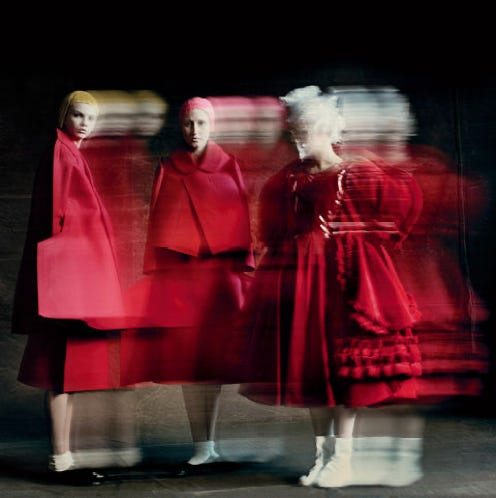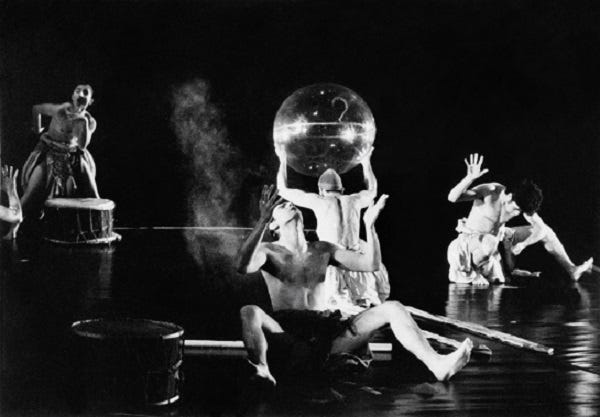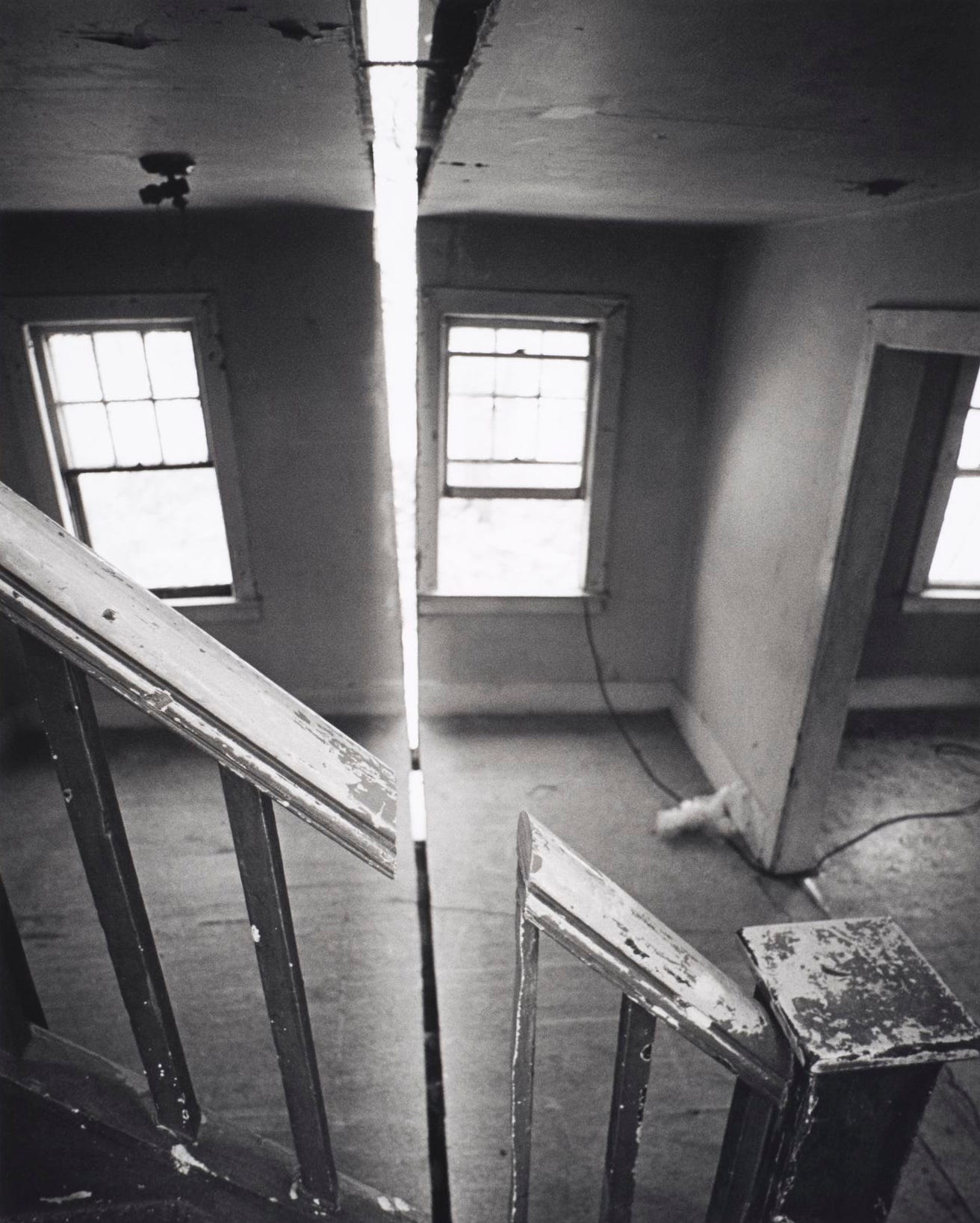The Art of Transitions
Doors. Blackouts. The god Hermes... and what a lot of directors forget.
This is the third installment of my newsletter about theater, process and practice. If you’re new: Welcome! You can find the previous two installments here: We All Need a Prehistory and A Heap Of Broken Images.
Legs, by Chantal CaduffHow do we get from here to there?
We ask ourselves this question (perhaps without noticing) hundreds of times a day—from navigating traffic to dreaming of a vacation.
Now scale it up: how do we, as a species, shift towards a cleaner future? How do we move from conflict to healing?
Today I want to talk about the how of transformation by looking at something rather niche, something particular to the theater but that echoes beyond the stage: the art of transitions.
Comme des Garçons, fashion designs by Rei Kawakubo
Transitions are a director’s choreography of change. And they are really hard to do well.
There are many kinds of transitions, but consider the moments between scenes in a production: lights shift, music swells, actors move, set pieces waltz in and out, then it all settles and the next scene begins.
If you’re a theatergoer, you’ve probably seen this a hundred times: it’s the standard scene change. Functional? Yes. Memorable? Not so much. It has become a convention—convenient and uninspired.
Leon Ingulsrud argues that the age of electricity dulled our sense of the theatrical. The blackout button on the lighting board made directors (and playwrights) lazy. We forgot how to craft not just proper scene endings, but their beginnings as well. (Film, with its grammar of jump cuts and dissolves, also likely played a part.)
Now, do transitions always need to be memorable?
Nope. Sometimes the most artful transitions are invisible to the spectator.
My argument here is that transitions are one of theater’s secret weapons. When they are crafted with intention (by directors, by playwrights) they can express core theatrical values to the audience. They can become subtext laid bare.
As an example, contrast the standard scene change with the way Greek tragedy moved from one scene to the next when it was performed in the fifth century BCE. No blackouts in an outdoor theater under the harsh Athenian sun!
Instead, Attic drama devised elaborate processions, choral songs and dances to move the story from here to there. These weren’t mere time-fillers while the main actors caught their breath and switched masks. Rather, they functioned as a “drawbridge” (to use George Steiner’s term) between spectators and story. They shifted the mood. They re-framed the myth. They dramatized the kinds of discussions and arguments central to the life of a democracy. These moments transformed the play’s tendons (its connective tissue) into the marrow of theater itself.
The Chorus in Bacchai, directed by Theodoros Terzopoulos
This isn’t about nostalgia for the past. Rather, it’s a provocation.
Why are transitions in so much of our contemporary theater so artless?
The logic of capitalism seems to have conquered the stage: speed and efficiency are the metrics many directors employ to cross from A to B.
In the process, they neglect the elegance of the hinge.
They overlook the power of the threshold.
They forget that Hermes (the trickster, the messenger) is the god of transitions.
Hermès - La Metamorphose by Liv AndareWhat messages can transitions deliver?
In the theater, a production’s quality almost always reveals itself in that first crucial shift at the top of the show, in the way a director moves an audience from the real world into the world of the story.
When I’m in my seat waiting for the play to start and I notice the conventional “house lights dimming to half, house lights dimming to dark” I wince. For in that moment the message is clear: the odds of experiencing something extraordinary have just plummeted to near zero.
Contrast this with how Ivo van Hove opens his production of The Damned, which explores the entanglements of a German industrialist family with the Nazi regime:
This jarring way to start the show isn’t a gimmick. It’s a message.
Van Hove takes us from the world of convention (spectators finding their seats) to the terror of the Third Reich through a use of sound, blocking and technology that’s anything but conventional. He subverts the visual cliché of the blackout by placing it where it never happens: at the top of the show and on the “wrong” side of the proscenium: where the audience sits. He weaponizes light because darkness and the sudden collapse of normality are central to a story about the rise of Hitler.
In his hands a simple transition becomes metaphor. Eloquent and brutal: a site for revelation.
Splitting by Gordon Matta ClarkSo far I’ve been talking about theater but, secretly, I’ve been trying to talk about life.
Because our existence is woven from transitions: the milestones like puberty, falling in love, or relocating to a new city; and the everyday shifts that move our routine along, like driving to work, or watching a sunset.
Recent conversations with my friend and artist extraordinaire Ajani Brannum, have pushed me to consider the ways in which my artistic practice is (and is not) also a spiritual practice. That question probably deserves a separate Substack entry, but for now, let me acknowledge that, in what follows, I’m going to sound less like a theater geek and more like a pesky meditation coach.
Here’s the thing: I’m convinced that our lives resonate more deeply when we approach every transition, grand or humble, with the intentionality of a skilled director.
Consider treating them all as rites of passage.
How might that awaken our presence?
What if that long flight was not something to endure, but a chance for inner change? What if even the way we cross a street or start a meal could reflect our deepest values?
Of course, this heightened approach to transitions isn’t just theoretical, but a lived reality for many. I’ve been reading Maia Kobabe’s Gender Queer and Pageboy by Elliot Page, both memoirs about the trans/non-binary experience. Their journey suggests that:
Meaningful transitions are forged with intention. There’s nothing casual about claiming your true identity, there’s no flipping a switch. Self-reflection and courage are required.
Transitions benefit from experimentation. A sense of play, of adventure, of trying things on for size, is vital for finding authenticity.
There is tension. For trans folks, it’s the friction between inner truth and how the world sees them. Yet, for all of us, tension —like a bowstring pulled taut— is what allows for metamorphosis.
Incidentally, these three concepts can also help directors craft better transitions in the theater. They can also be applied to our daily lives.
To end, I leave you with an invitation to try this practice:
As you move through your day, experiment with noticing transitions.
Start with something simple: getting out of bed, your commute to work, or a break between tasks.
Just acknowledge what you’re doing: “I’m opening my car door now.” Is there a tension, however small, at work in this moment? Perhaps you feel the opposing forces of needing to hurry and wanting to linger in the presence of something beautiful?
Could this transition feel different? What if you took one extra breath before opening the door?
For inspiration (and because I love his movies), I leave you with this beautiful video essay on the many doors and philosophical thresholds in the films of that master of transitions, Robert Bresson.
Once There Was Everything, a video essay by Kogonada (4:58 min) “The door is where all the drama occurs.”
Like Bresson, may we find the extraordinary every time we cross a threshold. May we practice the art of transitions.







A couple composition teachers of mine pointed out that transitions are the substance of choreography... such a difficult lesson to learn, but a deep one. I appreciate the shout-out! Here's to becoming a pesky meditation coach!